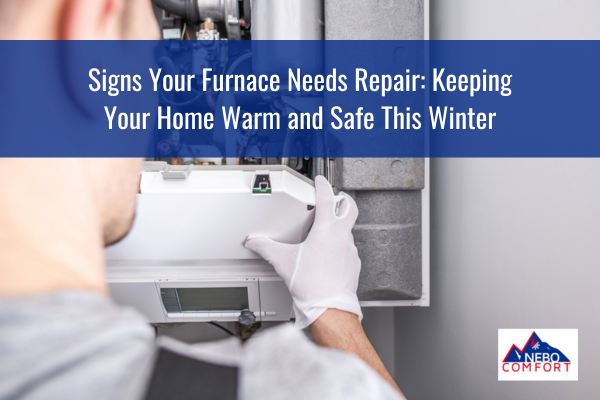As the crisp autumn air settles over the majestic peaks and valleys of Utah, the thought of a warm, comfortable home becomes increasingly inviting. For many homeowners, the furnace is the unsung hero of winter, silently working to keep the cold at bay. But what happens when your old furnace starts showing its age, struggling to keep up, or worse, breaks down entirely? The prospect of choosing a new furnace can feel overwhelming, given the array of options, technical jargon, and significant investment involved.
This article is designed to demystify the process of selecting a new furnace. We’ll walk you through every critical consideration, from understanding different furnace types and efficiency ratings to sizing your unit correctly and navigating installation. Our goal is to empower you with the knowledge needed to make an informed decision that ensures your Utah home remains warm, comfortable, and energy-efficient for years to come.
For expert guidance, professional installation, and unparalleled customer service in Utah, look no further than Nebo Comfort. Our team is dedicated to helping you choose the perfect furnace tailored to your home’s unique needs.
Why Replace Your Furnace? Signs It’s Time for an Upgrade
Before diving into the selection process, it’s helpful to recognize the signs that your current furnace might be nearing the end of its life or costing you too much to operate:
- Age: Most furnaces have a lifespan of 15-20 years. If your furnace is approaching or exceeding this age, it’s wise to consider replacement.
- Frequent Repairs: Are you constantly calling for repairs? The cost of frequent fixes can quickly add up and might even surpass the cost of a new, more reliable unit.
- Rising Energy Bills: An old or inefficient furnace has to work harder to heat your home, leading to significantly higher energy consumption and utility bills.
- Uneven Heating: Cold spots in certain rooms could indicate that your furnace is struggling to distribute heat effectively, often due to declining efficiency.
- Unusual Noises: Banging, squealing, rattling, or frequent cycling noises are all indicators that your furnace is under strain and potentially nearing failure.
- Yellow Pilot Light (Gas Furnaces): A healthy pilot light should be blue. A yellow or flickering pilot light could signal incomplete combustion, potentially producing dangerous carbon monoxide.
- Carbon Monoxide Detector Alarms: This is a serious safety concern. If your carbon monoxide detector goes off, evacuate immediately and call emergency services, followed by an HVAC professional.
Understanding Furnace Types: Fueling Your Comfort
The type of furnace you choose will largely depend on the available fuel sources in your area and your personal preferences. The most common types include:
- Natural Gas Furnaces:
- Pros: Most common in Utah due to widespread availability and lower fuel costs compared to electricity or propane. They offer quick, consistent heat.
- Cons: Requires a gas line connection. Potential for carbon monoxide leaks if not properly maintained.
- Ideal For: Most residential homes with access to natural gas lines.
- Propane Furnaces:
- Pros: A good alternative for homes without natural gas access. Offers similar heating performance to natural gas.
- Cons: Requires an on-site storage tank and regular fuel deliveries. Propane costs can fluctuate more than natural gas.
- Ideal For: Rural homes or areas where natural gas infrastructure is unavailable.
- Electric Furnaces:
- Pros: Lower upfront cost, simpler installation as they don’t require gas lines or vents. No risk of carbon monoxide.
- Cons: Generally the most expensive to operate in areas with high electricity rates (like parts of Utah) due to the lower efficiency of converting electricity directly into heat compared to burning fossil fuels.
- Ideal For: Smaller homes, mild climates (less common as a primary heat source in Utah’s cold winters), or as a backup for a heat pump.
- Oil Furnaces:
- Pros: Provides powerful heat.
- Cons: Requires an on-site storage tank and deliveries. Fuel oil is generally more expensive and less environmentally friendly than natural gas. Less common in Utah homes built today.
- Ideal For: Existing homes where oil is the primary heating source and conversion to gas is not feasible.
- Heat Pumps (Often Paired with a Furnace):
- Pros: Highly energy-efficient for both heating and cooling. They transfer heat rather than generating it, significantly reducing energy consumption. Can be paired with a gas furnace (dual-fuel system) for optimal performance in very cold temperatures.
- Cons: Higher upfront cost than traditional furnaces. Efficiency can drop in extremely low temperatures, making a dual-fuel system ideal for Utah winters.
- Ideal For: Homeowners looking for year-round climate control and maximum energy efficiency.
Ready for a Warm, Efficient Winter?
Let Nebo Comfort make it easy! Our experts will help you select and install the perfect, high-efficiency furnace tailored to your needs in Utah.
Understanding Furnace Efficiency: AFUE Ratings
One of the most critical factors when choosing a new furnace is its efficiency, measured by its Annual Fuel Utilization Efficiency (AFUE) rating. The AFUE percentage indicates how much of the fuel consumed is converted into usable heat, with the remaining percentage lost through the exhaust.
- Minimum AFUE: In the U.S., new furnaces must meet a minimum AFUE standard. As of 2015, the minimum AFUE for new gas furnaces is 80% for non-condensing models and 90% for condensing models in certain regions.
- Standard Efficiency (80% AFUE): These furnaces are less expensive upfront but are less efficient, meaning more heat escapes through the flue.
- Mid-Efficiency (80-89% AFUE): A step up from standard, offering better fuel utilization.
- High-Efficiency/Condensing (90-98.5% AFUE): These furnaces extract more heat from the combustion gases by using a secondary heat exchanger to condense water vapor, capturing latent heat. They are more expensive initially but offer significant long-term energy savings, especially in colder climates like Utah. They require a PVC exhaust pipe for the condensed water.
Considerations for AFUE: While a higher AFUE means greater energy savings, the payback period for the higher upfront cost depends on your climate, how often you use your furnace, and fuel costs. For Utah’s cold winters, a high-efficiency furnace is generally a wise investment.
Sizing Your New Furnace: The Goldilocks Principle
Choosing the right size furnace for your home is paramount. An oversized furnace will short-cycle (turn on and off too frequently), leading to inefficient operation, premature wear and tear, and uneven heating. An undersized furnace will run constantly, struggle to heat your home, and also wear out quickly. Neither extreme is ideal.
Furnace size is measured in British Thermal Units (BTUs), representing the amount of heat required to raise the temperature of one pound of water by one degree Fahrenheit.
- Don’t Rely on Old Sizing: Never assume your old furnace was correctly sized. Older homes or systems might have been sized incorrectly, or your home’s insulation, windows, or layout might have changed.
- Professional Load Calculation (Manual J): The most accurate way to size a furnace is through a professional “Manual J” load calculation. This takes into account various factors unique to your home:
- Square footage and ceiling height
- Local climate data (average winter temperatures in Utah)
- Number and type of windows and doors (e.g., single-pane vs. double-pane)
- Insulation levels in walls, attic, and floors
- Number of occupants
- Heat-generating appliances
- Ductwork condition and design
- Home orientation (north, south, east, west exposure)
Features and Technologies to Consider
Modern furnaces come with a range of features designed to enhance comfort, efficiency, and convenience:
- Single-Stage Furnaces: Operate at one speed (full capacity) whenever heat is called for. Least expensive, but less efficient and can lead to wider temperature swings.
- Two-Stage (Dual-Stage) Furnaces: Have two heat output settings: a lower setting for mild days and a higher setting for colder days. They run longer at a lower capacity, providing more consistent heat, better comfort, quieter operation, and improved efficiency.
- Modulating Furnaces: Offer the highest level of comfort and efficiency. They can precisely adjust their heat output in small increments (e.g., 40-100% capacity) to perfectly match your home’s heating needs, virtually eliminating temperature swings. They also run longer at very low capacities, leading to excellent air filtration and quiet operation.
- Variable-Speed Blower Motor: A variable-speed blower motor continuously adjusts its speed to precisely control airflow, providing superior comfort, quiet operation, and enhanced energy efficiency. It also improves humidity control and air filtration. Often found in two-stage and modulating furnaces.
- Zoning Systems: If you have multiple living areas with different heating needs, a zoning system allows you to control temperatures independently in different zones of your home, reducing energy waste and improving comfort.
- Smart Thermostat Compatibility: Most new furnaces are compatible with smart thermostats, allowing for remote control, learning capabilities, and integration with smart home systems.
- Humidity Control: Some advanced furnaces can integrate with whole-home humidifiers or dehumidifiers to maintain optimal indoor humidity levels, improving comfort and potentially reducing heating costs.
- Quiet Operation: Look for models with insulated cabinets and variable-speed blowers if quiet operation is a priority.
The Installation Process: Why Professionalism Matters
Even the most advanced and efficient furnace will underperform if it’s not installed correctly. Professional installation is non-negotiable for several reasons:
- Safety: Improper installation of gas lines, electrical wiring, or venting can create serious safety hazards, including gas leaks or carbon monoxide poisoning.
- Efficiency: A poorly installed furnace will not achieve its advertised AFUE rating, costing you more in energy bills. Proper ductwork sealing and sizing are also critical for efficiency.
- Longevity: Correct installation reduces strain on the system, extending its lifespan and reducing the likelihood of premature breakdowns.
- Warranty Validation: Most furnace manufacturers require professional installation for the warranty to remain valid.
- Permits and Codes: Licensed HVAC contractors are familiar with local building codes and will obtain necessary permits, ensuring your installation meets all regulatory requirements.
Working with Your HVAC Contractor
Choosing the right HVAC contractor is as important as choosing the right furnace. Here’s what to look for:
- Experience and Licensing: Ensure they are licensed, insured, and have a strong track record.
- Reputation: Check online reviews and ask for references. Look for companies with positive feedback on reliability, professionalism, and customer service.
- In-Home Assessment: A reputable contractor will conduct a thorough in-home assessment and Manual J load calculation, not just give a quote over the phone.
- Detailed Quotes: Get a written quote that clearly outlines the furnace model, AFUE rating, installation costs, warranty details, and any additional services.
- Warranty Information: Understand both the manufacturer’s warranty on the equipment and the contractor’s warranty on the installation.
- Maintenance Plans: Ask about ongoing maintenance plans, which can help protect your investment and keep your furnace running optimally.
Financing Your New Furnace
A new furnace is a significant investment. Explore your financing options:
- HVAC Contractor Financing: Many contractors offer financing plans, often with special interest rates.
- Personal Loan: Consider a personal loan from a bank or credit union.
- Home Equity Line of Credit (HELOC): If you have equity in your home, a HELOC can offer competitive interest rates.
- Energy Efficiency Rebates: Check with your local utility company (e.g., Rocky Mountain Power, Dominion Energy Utah) and federal programs for potential rebates or tax credits for installing high-efficiency furnaces. These can significantly offset the initial cost.
Conclusion
Choosing a new furnace is a critical decision that impacts your home’s comfort, safety, and energy costs for years to come. By understanding the different types, efficiency ratings, proper sizing techniques, and the importance of professional installation, you can navigate this process with confidence. Investing in the right furnace for your Utah home means enjoying a warm, consistent, and efficient heating system even during the coldest winter days.
Don’t face the chill of winter with an old, unreliable furnace. Let the experts at Nebo Comfort guide you through every step of selecting and installing your perfect new heating system.
Are you located in Utah and ready to upgrade your home’s warmth and efficiency? Contact Nebo Comfort today or view our services to schedule a consultation and get a free estimate. We’re here to ensure your ultimate comfort this winter!
















